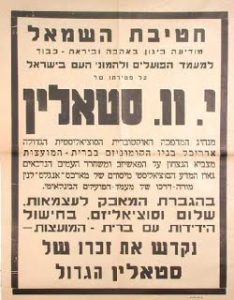Who was Josef Stalin?
From his wiki page:
With a high number of excess deaths occurring under his rule, Stalin has been labeled "one of the most notorious figures in history".[863] These deaths occurred as a result of collectivisation, famine, terror campaigns, disease, war and mortality rates in the Gulag. As the majority of excess deaths under Stalin were not direct killings, the exact number of victims of Stalinism is difficult to calculate due to lack of consensus among scholars on which deaths can be attributed to the regime.
Official records reveal 799,455 documented executions in the Soviet Union between 1921 and 1953; 681,692 of these were carried out between 1937 and 1938, the years of the Great Purge. However, according to Michael Ellman, the best modern estimate for the number of repression deaths during the Great Purge is 950,000–1.2 million, which includes executions, deaths in detention, or soon after their release. In addition, while archival data shows that 1,053,829 perished in the Gulag from 1934 to 1953, the current historical consensus is that of the 18 million people who passed through the Gulag system from 1930 to 1953, between 1.5 and 1.7 million died as a result of their incarceration. The historian and archival researcher Stephen G. Wheatcroft and Michael Ellman attribute roughly 3 million deaths to the Stalinist regime, including executions and deaths from criminal negligence. Wheatcoft and historian R. W. Davies estimate famine deaths at 5.5–6.5 million while scholar Steven Rosefielde gives a number of 8.7 million. The American historian Timothy D. Snyder in 2011 summarised modern data, made after the opening of the Soviet archives in the 1990s, and concludes that Stalin's regime was responsible for 9 million deaths, with 6 million of these being deliberate killings. He notes that the estimate is far lower than the estimates of 20 million or above which were made before access to the archives.
Historians continue to debate whether or not the 1932–33 Ukrainian famine—known in Ukraine as the Holodomor—should be called a genocide.[902] Twenty six countries officially recognise it under the legal definition of genocide. In 2006, the Ukrainian Parliament declared it to be such,[903] and in 2010 a Ukrainian court posthumously convicted Stalin, Lazar Kaganovich, Stanislav Kosior, and other Soviet leaders of genocide. Popular among some Ukrainian nationalists is the idea that Stalin consciously organised the famine to suppress national desires among the Ukrainian people. This interpretation has been rejected by more recent historical studies. These have articulated the view that—while Stalin's policies contributed significantly to the high mortality rate—there is no evidence that Stalin or the Soviet government consciously engineered the famine. The idea that this was a targeted attack on the Ukrainians is complicated by the widespread suffering that also affected other Soviet peoples in the famine, including the Russians. Within Ukraine, ethnic Poles and Bulgarians died in similar proportions to ethnic Ukrainians. Despite any lack of clear intent on Stalin's part, the historian Norman Naimark noted that although there may not be sufficient "evidence to convict him in an international court of justice as a genocidaire[...] that does not mean that the event itself cannot be judged as genocide.
A really really really BAD dude!!! One of the most evil men in world history.
YET, oddly enough, he was followed and revered by many Jews. When he died, he was mourned by many Jews as well [see below].
I am reminded of the line: "When men stop believing in God, they don't believe in nothing. They believe in anything." This is an age old lesson that reverberates until this day. When people abandon Hashem, they seek false or even evil ideologies.



